2023 Sun April 2
Bishop Curry sets the scene for Palm Sunday
Easter 2017 Message

“It’s taken me some years to realize it, but Jesus didn’t just happen to be in Jerusalem on that first Palm Sunday. He wasn’t on vacation. He wasn’t just hanging out in town. Jesus was in Jerusalem on purpose. He arrived in Jerusalem about the time of the Passover when pilgrims were in the city. When people’s hopes and expectations for the dawn of freedom that Moses had promised in the first Passover might suddenly be realized for them in their time.
“Jesus arranged his entrance into Jerusalem to send a message. He entered the city, having come in on one side of the city, the scholars tell us, at just about the same time that Pontius Pilate made his entrance on the exact opposite side of the city. Pilate, coming forth on a warhorse. Pilate, with soldiers around him. Pilate, with the insignias of Rome’s Empire. Pilate, representing the Caesars who claimed to be son of god. Pilate, who had conquered through Rome the people of Jerusalem. Pilate, representing the Empire that had taken away their freedom. Pilate, who represented the Empire that would maintain the colonial status of the Jewish people by brute force and violence.
“Jesus entered the city on the other side, not on a warhorse, but on a donkey, recalling the words of Zechariah:
Behold your King comes to you
Triumphant and victorious is He
Humble and riding on a donkey
“Jesus entered the city at the same time as Pilate to show them, and to show us, that God has another way. That violence is not the way. That hatred is not the way. That brute force and brutality are not the way.
“Jesus came to show us there is another way. The way of unselfish, sacrificial love. That’s why he entered Jerusalem. That’s why he went to the cross. It was the power of that love poured out from the throne of God, that even after the horror of the crucifixion would raise him from death to life.
“God came among us in the person of Jesus to start a movement. A movement to change the face of the earth. A movement to change us who dwell upon the earth. A movement to change the creation from the nightmare that is often made of it into the dream that God intends for it.
“He didn’t just happen to be in Jerusalem on that Palm Sunday. He went to Jerusalem for a reason. To send a message. That not even the titanic powers of death can stop the love of God. On that Easter morning, he rose from the dead, and proclaimed love wins.
“So you have a blessed Easter. Go forth to be people of the Resurrection. Follow in the way of Jesus. Don’t be ashamed to love. Don’t be ashamed to follow Jesus.
“Have a blessed Easter. And bless the world. Amen.”
The Most Rev. Michael B. Curry
Presiding Bishop and Primate
The Episcopal Church
Bishop Curry’s Easter Message 2017 provides a stirring message to set the scene at Palm Sunday.
The arrival in Jerusalem is the culmination of Gospel readings since Epiphany. In Luke 9:51 Jesus “sets his face to go to Jerusalem” and concludes nearly ten chapters later (19:27) with Jesus’ arrival in Jerusalem.
Curry – “He didn’t just happen to be in Jerusalem on that Palm Sunday. He went to Jerusalem for a reason. To send a message. That not even the titanic powers of death can stop the love of God. On that Easter morning, he rose from the dead, and proclaimed love wins.”
The scholars he mentions are probably Marcus Borg and John Dominic Crossan whose book “The Last Week” is a day-by-day accounting of Holy Week. We will feature selections from the book next week. In their book, Palm Sunday was the collision of 2 kingdoms – one based in Rome and one based with Jesus with differing value systems.
Meanings, Path, and Art of Palm Sunday
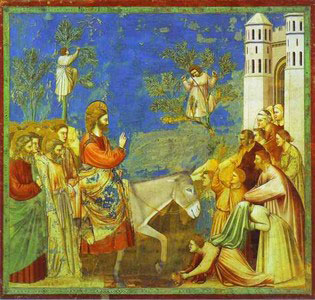
The biblical story of Palm Sunday is recorded in all four of the Gospels (Matthew 21:1-11; Mark 11:1-10; Luke 19:28-38; and John 12:12-18). Five days before the Passover, Jesus came from Bethany to Jerusalem. Having sent two of His disciples to bring Him a colt of a donkey, Jesus sat upon it and entered the city.
People had gathered in Jerusalem for the Passover, the most sacred week of the Jewish Year and were looking for Jesus, both because of His great works and teaching and because they had heard of the miracle of the resurrection of Lazarus. When they heard that Christ was entering the city, they went out to meet Him with palm branches, laying their garments on the ground before Him, and shouting, “Hosanna! Blessed is he that comes in the Name of the Lord, the King of Israel!”
From the east, Jesus rode a donkey down the Mount of Olives, cheered by his followers. He rides the colt to the city surrounded by a crowd of enthusiastic followers and sympathizers, who spread their cloaks, strew leafy branches on the road, and shout, “Hosanna! Blessed is the one who comes in the name of the Lord! Blessed is the coming kingdom of our ancestor David! Hosanna in the highest heaven!”
Jesus was from the peasant village of Nazareth, his message was about the kingdom of God, and his followers came from the peasant class. They had journeyed to Jerusalem from Galilee, about a hundred miles to the north, a journey that is the central section and the central dynamic of Mark’s gospel. Mark’s story of Jesus and the kingdom of God has been aiming for Jerusalem, pointing toward Jerusalem. It has now arrived. On the opposite side of the city, from the west, Pontius Pilate, the Roman governor of Idumea, Judea, and Samaria, entered Jerusalem at the head of a column of imperial cavalry and soldiers
At the outset of His public ministry Jesus proclaimed the kingdom of God and announced that the powers of the age to come were already active in the present age (Luke 7:18-22, Mark 1:14-15). His words and mighty works were performed “to produce repentance as the response to His call, a call to an inward change of mind and heart which would result in concrete changes in one’s life, a call to follow Him and accept His messianic destiny. The triumphant entry of Jesus into Jerusalem is a messianic event, through which His divine authority was declared.
Mark concludes his advance summary of Jesus’s message with, “Repent, and believe in the good news” (1:15).
The word “repent” has two meanings here, both quite different from the later Christian meaning of contrition for sin. From the Hebrew Bible, it has the meaning of “to return,” especially “to return from exile,” an image also associated with “way,” “path,” and “journey.” To believe in the good news,” as Mark puts it, means to trust in the news that the kingdom of God is near and to commit to that kingdom. And to whom did Jesus direct his message about the kingdom of God and the “way”? Primarily peasants
In Mark (and the other gospels), Jesus never goes to a city (except Jerusalem, of course). Though the first half of Mark is set in Galilee, Mark does not report that Jesus went to its largest cities, Sepphoris and Tiberias, even though the first is only four miles from Nazareth and the second is on the shore of the Sea of Galilee, the area of most of Jesus’s activity. Instead, Jesus speaks in the countryside and in small towns like Capernaum. Why? The most compelling answer is that Jesus saw his message as to and for peasants
Jerusalem becomes central in the section of Mark that tells the story of Jesus’s journey from Galilee to Jerusalem. It begins roughly halfway through Mark with Peter’s affirmation that Jesus is the Messiah. The next two and a half chapters, leading to Jesus’s entry into Jerusalem on Palm Sunday, are about what it means to follow Jesus, to be a genuine disciple. Mark develops this theme by weaving together several subthemes:
• Following Jesus means following him on the way.
• The way leads to Jerusalem.
• Jerusalem is the place of confrontation with the authorities.
Jerusalem is the. place of death and resurrection
Commonly called the “first prediction of the passion,” it is followed by two more solemn announcements anticipating Jesus’s execution that structure this part.
Each of these anticipations of Jesus’s execution is followed by teaching about what it means to follow Jesus.
3 meanings of Palm Sunday
1. Palm Sunday summons us to behold our king: the Word of God made flesh. We are called to behold Him not simply as the One who came to us once riding on a colt, but as the One who is always present in His Church, coming ceaselessly to us in power and glory at every Eucharist, in every prayer and sacrament, and in every act of love, kindness and mercy. He comes to free us from all our fears and insecurities, “to take solemn possession of our soul, and to be enthroned in our heart,” as someone has said. He comes not only to deliver us from our deaths by His death and Resurrection, but also to make us capable of attaining the most perfect fellowship or union with Him. He is the King, who liberates us from the darkness of sin and the bondage of death. Palm Sunday summons us to behold our King: the vanquisher of death and the giver of life.
In the gospels, the movements of both John the Baptist and Jesus had an anti-temple dimension. John’s baptism was for the “forgiveness of sins.” But forgiveness was a function that temple theology claimed for itself, mediated by sacrifice in the temple. Like John, Jesus pronounced forgiveness apart from temple sacrifice. It is implicit in much of his activity, including his eating with “tax collectors and sinners,” who were seen as intrinsically impure, but it becomes explicit as well
Thus in these voices from the time of Jesus, Jerusalem with its temple was still seen as “the city of God” that called forth Jewish devotion. But it was also the center of a local domination system, the center of the ruling class, the center of great wealth, and the center of collaboration with Rome.
2. Palm Sunday summons us to accept both the rule and the kingdom of God as the goal and content of our Christian life.
In Mark, Jesus’s message is not about himself-—not about his identity as the Messiah, the Son of God, the Lamb of God, the Light of the World, or any of the other exalted terms familiar to Christians. Of course, Mark affirms that Jesus is both the Messiah and the Son of God; he tells us so in the opening verse of the gospel: “The beginning of the good news of Jesus Christ, the Son of God.”
But this is not part of Jesus’s own message. He neither proclaims nor teaches this, nor does this form part of his followers’ teaching during his lifetime. Rather, in Mark only voices from the Spirit world speak of Jesus’s special identity. It is about the kingdom
In the first century, “kingdom” was a political term. Jesus’s hearers (and Mark’s community) knew of and lived under kingdoms: the kingdoms of Herod and his sons, the kingdom of Rome. Jesus could have spoken of the family of God, the community of God, or the people of God, but, according to Mark, he spoke of the kingdom of God. To his hearers, it would have suggested a kingdom very different from the kingdoms they knew, very different from the domination systems that ruled their lives. And Jesus’s message in Mark, is about the already present kingdom of God that is also yet to come in its fullness.
We draw our identity from Christ and His kingdom. The kingdom is Christ – His indescribable power, boundless mercy and incomprehensible abundance given freely to man. The kingdom does not lie at some point or place in the distant future. In the words of the Scripture, the kingdom of God is not only at hand (Matthew 3:2; 4:17), it is within us (Luke 17:21). The kingdom is a present reality as well as a future realization (Matthew 6:10). Theophan the Recluse wrote the following words about the inward rule of Christ the King:
“The Kingdom of God is within us when God reigns in us, when the soul in its depths confesses God as its Master, and is obedient to Him in all its powers. Then God acts within it as master ‘both to will and to do of his good pleasure’ (Philippians 2:13).
The kingdom of God is the life of the Holy Trinity in the world. It is the kingdom of holiness, goodness, truth, beauty, love, peace and joy. These qualities are not works of the human spirit. They proceed from the life of God and reveal God. Christ Himself is the kingdom.
3. Palm Sunday summons us to behold our king – the Suffering Servant. We cannot understand Jesus’ kingship apart from the Passion. Filled with infinite love for the Father and the Holy Spirit, and for creation, in His inexpressible humility Jesus accepted the infinite abasement of the Cross. He bore our griefs and carried our sorrows; He was wounded for our transgressions and made Himself an offering for sin (Isaiah 53). His glorification, which was accomplished by the resurrection and the ascension, was achieved through the Cross.
In the fleeting moments of exuberance that marked Jesus’ triumphal entry into Jerusalem, the world received its King, the king who was on His way to death. His Passion, however, was no morbid desire for martyrdom. Jesus’ purpose was to accomplish the mission for which the Father sent Him.

21 Triumphal Entry into Jerusalem
Jesus’ triumphal entry into Jerusalem during the Feast of Passover is recorded in Luke 19:35-38 and Mark 11:7-10.
His triumphal entry was prophesied in Psalm 118 and Zechariah 9:9. Part of the observance of the Feast of Passover was the reciting of the Hallel (Psalm 118). The words of Psalm 118 were shouted by the people as Jesus entered the gates of Jerusalem seated on a colt, the foal of a donkey, as was prophesied in Zechariah 9:9.
Prophecy – The Coming Messiah
“Rejoice greatly, O daughter of Zion; shout, O daughter of Jerusalem: behold, thy King cometh unto thee: he is just, and having salvation; lowly, and riding upon an ass, and upon a colt the foal of an ass.”
– Zechariah 9:9
Fulfillment
Mark 11:7-10
7 They brought the colt to Jesus and put their coats on it; and He sat on it. 8 And many spread their coats in the road, and others spread leafy branches which they had cut from the fields. 9 Those who went in front and those who followed were shouting:
“Hosanna! BLESSED IS HE WHO COMES IN THE NAME OF THE LORD;
10 Blessed is the coming kingdom of our father David; Hosanna in the highest!”
Luke 19:35-38
“And they brought him to Jesus: and they cast their garments upon the colt, and they set Jesus thereon. And as he went, they spread their clothes in the way. And when he was come nigh, even now at the descent of the mount of Olives, the whole multitude of the
disciples began to rejoice and praise God with a loud voice for all the mighty works that they had seen; Saying, Blessed be the King that cometh in the name of the Lord: peace in heaven, and glory in the highest.”
Prophecy – The Return of Jesus
The Beautiful Gate, also known as the Golden Gate, is located in the east wall of Jerusalem. It was open at the time of Jesuss triumphal entry into Jerusalem. The gate Jesus went through was destroyed in 70 A.D. The rebuilt gate was sealed by the Muslim conquerors in 1530 A.D. Ezekiel prophesied the closure of this gate around 600 B.C. and that the Prince (Messiah) will enter the gate in the future:
Ezekiel 44:1-3.
“Then he brought me back the way of the gate of the outward sanctuary which looketh toward the east; and it was shut. Then said the LORD unto me; This gate shall be shut, it shall not be opened, and no man shall enter in by it; because the LORD, the God of Israel, hath entered in by it, therefore it shall be shut. It is for the prince; the prince, he shall sit in it to eat bread before the LORD; he shall enter by the way of the porch of that gate, and shall go out by the way of the same.” – Ezekiel 44:1-3.
Recently another gate has been discovered directly beneath the Beautiful Gate. This may be the gate referred to in Scripture.
21a Alternate Triumphal Entry Gate
Jesus may have entered Jerusalem by the Sheep Gate north of the Temple complex. This would be consistent with His role as the Lamb of God, since it was through this gate that the sacrificial lambs were brought into the Temple.
1. Preparation for Christ’s Entry into Jerusalm (1135-1140)
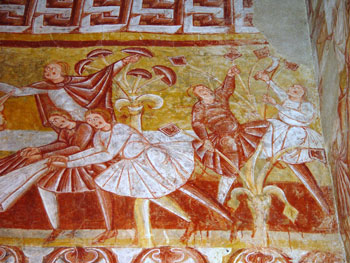
“The frescoes in the parish Church of St. Martin at Nohant-Vicq constitute one of the most extensive and best preserved ensembles of Romanesque monumental painting in central and southwestern France. …a prime example of a major work that has been studied almost exclusively from the standpoint of style. The single painter who executed the frescoes commanded a vigorous and powerful style…the painter’s distinctive manner of generating forms is accompanied by unusual interpretations of narrative subjects…The scene of the Entry [into Jerusalem] is…divided into two parts. The representation of Christ mounted on an ass and greeted by excited youths is contained in the upper register of the south wall. The fortified city of Jerusalem, its gates crowded with youths whose mouths are open in song,is isolated as a separate image…”(Kupfer, 38)”
2. Giotto di Bonde, Entry into Jerusalem (1304-06), Fresco, Cappella Scrovegni (Arena Chapel), Padua

Giotto di Bondone (1266/7 – January 8, 1337), better known simply as Giotto, was an Italian painter and architect from Florence in the late Middle Ages. He is generally considered the first in a line of great artists who contributed to the Italian Renaissance.
The late-16th century biographer Giorgio Vasari describes Giotto as making a decisive break with the prevalent Byzantine style and as initiating “the great art of painting as we know it today, introducing the technique of drawing accurately from life, which had been neglected for more than two hundred years.”
3. Duccio di Buoninsegna, detail, Entry into Jerusalem (1308-11)” tempera on wood, Museo dell’Opera

Duccio di Buoninsegna (c. 1255-1260 – c. 1318-1319) was one of the most influential Italian artists of his time. Born in Siena, Tuscany, he worked mostly with pigment and egg tempera and like most of his contemporaries painted religious subjects.
4 Pietro Lorenzetti, Entry of Christ into Jerusalem (c. 1320), Fresco, Lower Church, San Francesco, Assisi

Pietro Lorenzetti (or Pietro Laurati; c. 1280 – 1348) was an Italian painter, active between approximately 1306 and 1345. He was born and died in Siena. He was influenced by Giovanni Pisano and Giotto, and worked alongside Simone Martini at Assisi. He and his brother, Ambrogio Lorenzetti, helped introducenaturalism into Sienese art. In their artistry and experiments with three-dimensional and spatial arrangements, they foreshadowed the art of the Renaissance.Many of his religious works are in churches in Siena, Arezzo, and Assisi.
5 UNKNOWN MASTER, French, Three Scenes (1350-75), Alabaster, Museum Mayer van den Bergh, Antwerp
6 Fra Angelico The Entry into Jerusalem, St Mark, Florence

Fra Angelico (c. 1395[1] – February 18, 1455), born Guido di Pietro, was an Early Italian Renaissance painter described by Vasari in his Lives of the Artists as having “a rare and perfect talent”.[2]
7 Pedro Orrente, Entry into Jerusalem (c. 1520), oil on canvas, State Hermitage Museum, St. Petersburg

Pedro Orrente (1580 – 1645) was a Spanish painter of the Baroque period. Born in the village of Murcia. Orrente appears to have studied with el Greco inToledo, where he painted a San Ildefonso before the apparition of St Leocadia and the Birth of Christ for the cathedral. He often moved, painting in Murcia and Cuenca. In Valencia, he painted for the Cathedral. He set up a school, and among his pupils were Esteban March and García Salmerón.
8 Benjamin Robert Haydon, Christ’s Entry into Jerusalem (1814-20), Oil on canvas, 396 x 457 cm, Mount St Mary’s Seminary, Cincinnati
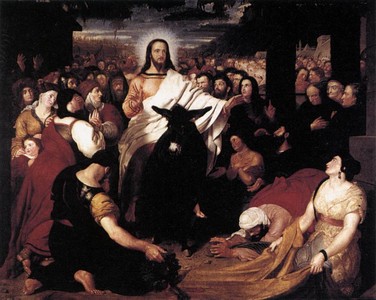
Benjamin Robert Haydon (26 January 1786 – 22 June 1846) was an English historical painterand writer.
9 Albrecht Dürer, Christ’s Entry into Jerusalem (1511), woodcut, The Small Passion Albrecht Dürer (German pronunciation: 21 May 1471 – 6 April 1528)[1] was a German painter, printmaker, engraver, mathematician, and theorist from Nuremberg. His prints established his reputation across Europe when he was still in his twenties, and he has been conventionally regarded as the greatest artist of the Northern Renaissance ever since. His vast body of work includes altarpieces and religious works, numerous portraits and self-portraits, and copper engravings.
• The Foal of Bethpage

• The Procession of the Apostles
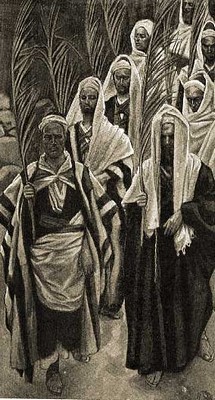
• Jesus Beheld the City and Wept over It
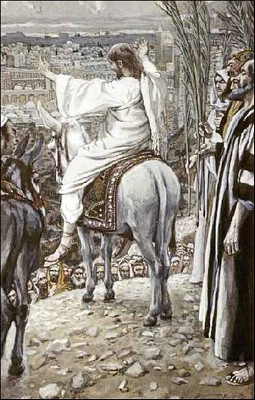
• Palm Sunday Procession on the Mount of Olives
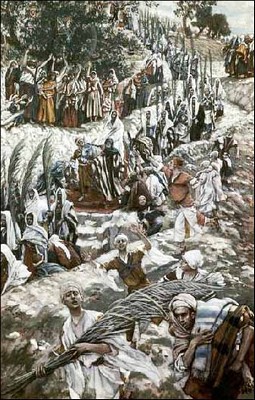
• Procession in the Streets of Jerusalem

• Jerusalem, Jerusalem

James J. Tissot was a well-known French impressionist painter, who in his later years travelled twice to the Holy Land in order to produced a series of 700 accurate watercolor drawings to illustrate the Old and New Testaments — especially the life of Christ.
11. Wilhelm Morgner Entry Into Jerusalem

Wilhelm Morgner, a German Expressionist painter, trained for the clergy, although he quickly turned to painting as his calling. His close identification with Jesus Christ manifested itself in works that expressed his powerful understanding of the Passion, exemplified here by his color-saturated vision of the Entry into Jerusalem. Sadly, he died a young man, one of millions, on the fields of Flanders during World War I. Still, his discipline to his work left enough paintings to allow reflection upon the creative response to a deep faith and love of Jesus Christ.
12. Photo of Palm Sunday (Cvjetnica) in Croatia, 2007
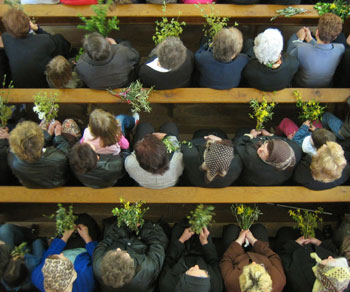
Palm Sunday
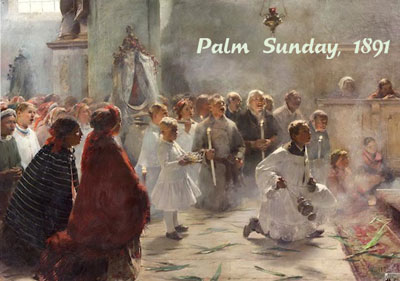
We are nearing the end of Lent. Lent proper began on Ash Wednesday and ends on Palm/Passion Sunday, a day that in turn inaugurates Holy Week.
While Palm Sunday marks Jesus’ triumphant entry into Jerusalem, the events of that day set in motion Jesus’ death 5 days later before the Passover begins. Zechariah had forecast “Zion’s king” coming “righteous and victorious” on a donkey. It looked like Jesus was proclaiming himself King of Israel to the anger of some of the Jewish authorities.
Palm Sunday has two liturgies – the Liturgy of the Palms where we consider Jesus arrival in Jerusalem from Galilee and the Liturgy of the Passion, a foreshadowing of Holy Week.
Palm Sunday is the hinge between Lent and Holy Week. Lent has been the 40 day season of fasting and spiritual preparation intended to understand in practices, ritual and disciplines critical to living in the way of Jesus and Holy Week. Holy Week is a time of more intense fasting, reading and prayers in which we pay particular attention to the final days, suffering, and execution of Jesus.
Palm Sunday Scenes
Palm Sunday is a unique Sunday with its range of emotions from jubilation and excitement at the beginning from the procession to the let down and horror during the Passion Story. The music also taps the wide range of emotions. Jesus is demonstrating his mission and the crowd believes that Jesus is the Messiah and that means that he will re-establish David’s kingdom. Fast forward to the passion reading which encompasses holy week. By Good Friday, many of those who were welcoming Jesus were now ready to crucify him
Palm Sunday is like a play with 6 scenes based on the 6 divisions within the image below. Hover on it and then click on one of the scenes to take you to a page with more information. The pages have a mixture of text, slides and videos. Based on event order:
- Liturgy of the Palms
- Procession
- Processional hymn – “All Glory Laud and Honor”
- Hymn based on Philippians reading – Philippians 2:5-11
- Passion Reading
- Sermon based on Palm Sunday symbols
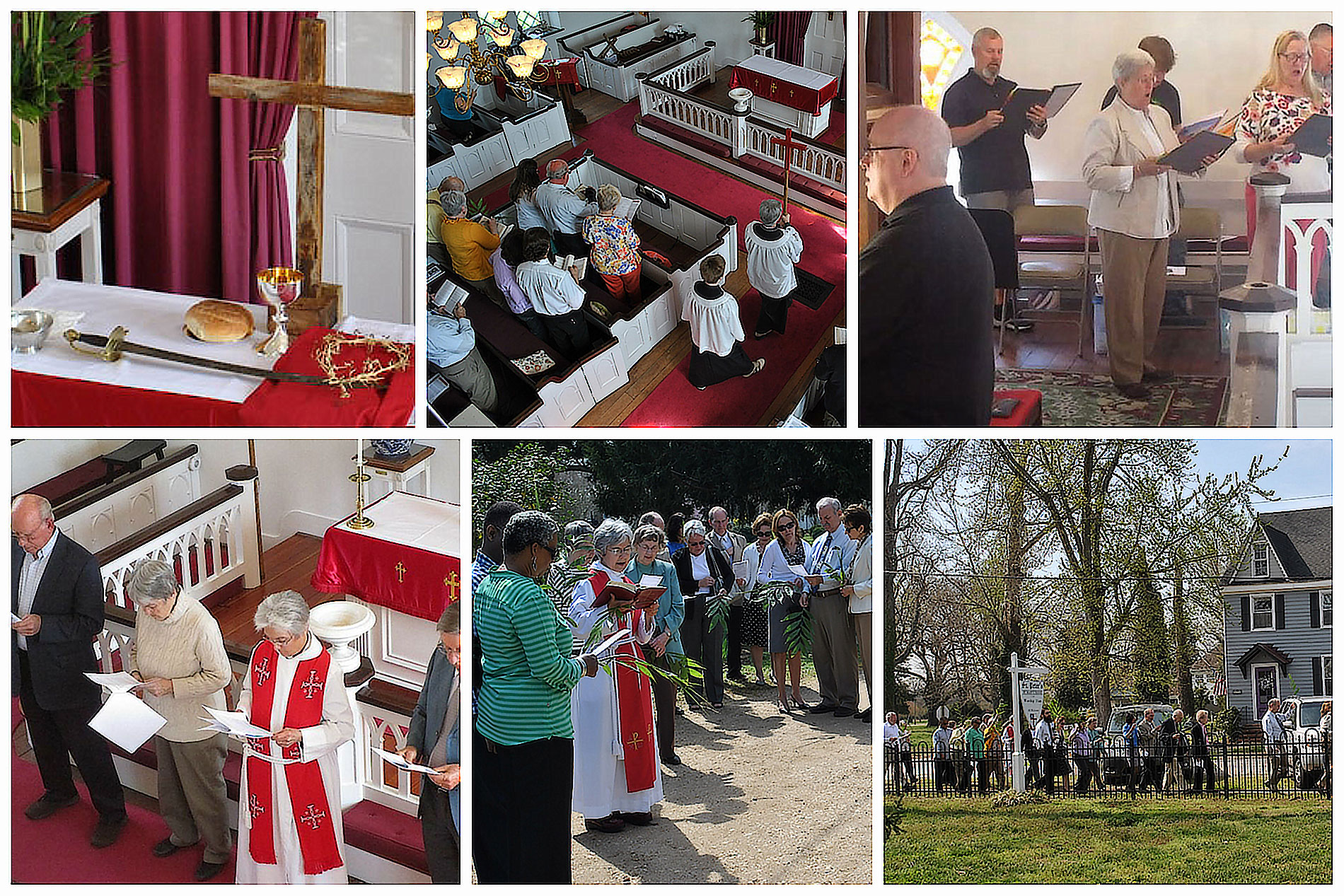
Voices – Palm Sunday
1. David Lose – Key to Palm Sunday
The key to the story – “Jesus suffers, that is, so that when we are suffering we know God understands and cares for us. Jesus is utterly alone by the end of the story so that when we feel alone we know God understands and is with us. Jesus cries out in despair so that when we become convinced the whole world has conspired against us and feel ready to give up, we know that God understands and holds onto us. Jesus dies because so that we know God understands death and the fear of death and reminds us that death does not have the last word. “All that we see and hear, all that we read and sing, all of this is for us. And so the fourth century theologian Athanasius, speaking of the Incarnation that reaches its climax in the crucifixion, said that God becomes like us in Jesus so that we may become like God. And twelve hundred years later, Martin Luther described the cross as the divine exchange where Jesus takes our life and lot that we may enjoy his righteousness and victory.
2. David Lose – Misunderstood meanings – being half right
…we might recall for our folks that Jesus’ triumphal entry wasn’t a first-century version of the Macy’s Thanksgiving Day Parade. It was a meant as a statement. Matthew is clear: Jesus rode into town as a returning king. Moreover, the crowds greeted him as such. The hosannas the people cry have both religious and political overtones. They greet him as the Lord’s Messiah and expect him to overthrow the Romans. And the Romans take note. This helps to explain why, in fact, he was crucified. It wasn’t just an accident. It wasn’t because he simply offended the religious authorities of the day. It was because he proclaimed another kingdom – the kingdom of God – and called people to give their allegiance to this kingdom first. He was, in other words, a threat. And even the briefest of readings from the Passion narrative reminds us of the consequences of Jesus challenge to the powers that be.
The tragedy of the day is that the people are half right. He did come as God’s Messiah. But they misunderstood what that meant – not “regime change” by violence, but rather the love of God poured out upon the world in a way that dissolved all the things we use to differentiate ourselves from others and the formation of a single humanity that knows itself – and all those around them! – as God’s beloved people.
The other tragedy of the day is that the religious and political authorities are also half right. Jesus was a threat. For that matter, he still is. He threatens our penchant to define ourselves over and against others. He threatens the way in which we seek to establish our future by hording wealth and power. He threatens our habit of drawing lines and making rules about who is acceptable and who is not. He threatens all of these things and more. But they are so wrong in thinking that they can eliminate this threat by violence. Jesus’ resurrection – which in Matthew is accompanied by the shaking of the very foundations of the earth – affirms that God’s love is stronger than hate and God’s love is stronger than death. And eventually all will yield to the mercy and majesty of God.
3. Lawrence – “Street Theatre”
This is the denouement – the unleashing of the storm that has been building with startling intensity and pace ever since the outset of Jesus’ ministry in Capernaum (1:21ff). Those earlier conflicts were played out against the backdrop of Jerusalem and the Temple, and we saw the fierce opposition Jesus provoked. The city extended its threatening hand deep into the margins of the Galilee. Now Jesus is bringing the fight to Jerusalem. It’s showdown time, and Mark signals its beginning with a suitably high-octane piece of street theatre: Jesus, a donkey, palm-waving crowds and a fevered outbreak of messianic political expectation.
Mark is drawing our attention yet again to the contrast between the reception that Jesus receives on the margins, among the ordinary rural people, and the reception he receives from Jerusalem as the centre of political and religious power. Those on the periphery hear his message of the kingdom and receive his ministry as Good News; those in the centre perceive it as threatening and maybe even demonic in origin. The crowds who shout “Hosanna!” (which comes from Psalm 118: 25 and is a cry to God meaning “Save now!”) are the rural peasants, rather than the urban elite of Jerusalem.
Mark casts Jesus’ approach to Jerusalem as a march upon the city – the climax of Jesus’ “campaign” of confrontation. Jerusalem was occupied by a hated foreign power. The cry, “Blessed is the coming kingdom of our ancestor, David!” is the cry of hope for the restoration of the Davidic monarchy, and therefore the overthrow of the Romans. This is political dynamite in the climate of the time. It would entail not only the overthrow of Imperial Rome, but the ousting of the collaborators – the Jewish ruling classes. Moreover, Mark wants us to understand that, if Jesus is indeed the leader of an imminent revolt, this revolution is not going to be one in a long list of failed popular uprisings that have ended in crucifixions. This one is the real thing!
He does this by placing the origin of the march “near the Mount of Olives”, a place associated in the early apocalyptic tradition with the final battle against the enemies of Israel in defence of Jerusalem: “I will gather the nations against Jerusalem to do battle, and the city shall be taken and the houses plundered … Then Yahweh will go forth and fight against those nations as when he fights on a day of battle. On that day, his feet shall stand on the Mount of Olives” (Zechariah 14: 2-4).
Palm Sunday, the Setting: “We are Going Up to Jerusalem”
From Killing Jesus – Bill O’Reilly, Martin Dugard

It is Sunday, April 2, A.D. 30. Pontius Pilate has just returned to Jerusalem and taken up residence in Herod the Great’s palace. Herod Antipas, the tetrarch, arrives in the city and stays just a block away, at the Hasmonean Palace. At the same time, Caiaphas prepares for the biggest festival of the year at his palace home in the Upper City.
Passover week is now about to begin.
The purification process is vital to properly celebrating Passover. It creates a physical and emotional state of mind that prepares a worshipper to embrace God’s holiness—thus the need to arrive in Jerusalem almost a week before the holy day
Anticipating the smell of roast lamb that will hang over Jerusalem as the Passover feasts are being cooked in ovens, the pilgrims count their money, worrying about how they will pay for that feast and the inevitable taxes they will incur in the city. Despite their sore feet and aching legs from walking mile after rugged mile through the wilderness, the travelers feel themselves transformed by the magnetic pull of Jerusalem. Their thoughts are no longer set on their farms back home and the barley crop that must be harvested immediately upon their return, but on holiness and purity
“We are going up to Jerusalem,” Jesus tells his disciples as they prepare to depart for the Passover…
Why was Jesus killed ?
Arland J. Hultgren
“People colluded to have Jesus killed. The most certain fact we have about Jesus as a historical person is that he was crucified under Pontius Pilate, just as we say in the Apostles’ Creed. Even though he had no intentions of being an earthly king, some people thought that that was what he wanted to be. The title on the cross says it all: “This is Jesus, the King of the Jews” (27:37). As such, his crucifixion was a political act by the Roman government. If Jesus claimed to be King of the Jews (which Pilate does not actually think, but others in power do), that was treasonous, requiring his death.”
From a Roman perspective, why did Jesus have to die?
• Because he disturbed Roman order.
• Because he spoke seditiously of a coming kingdom other than that of Caesar.
• Because he allowed himself to be called “King of the Jews.”
• Because he made a nuisance of himself at the wrong time (Passover), in the wrong place (Jerusalem), in the presence of the wrong people (Pilate and the temple leadership under his command).
• Because his crucifixion would be a powerful deterrent that might keep other Jews from following in his footsteps.
Father Jim Cook
“Jesus was executed for three reasons, says Luke: “We found this fellow subverting the nation, opposing payment of taxes to Caesar, and saying that He Himself is Christ, a King” (Luke 23:1–2). In John’s gospel the angry mob warned Pilate, “If you let this man go, you are no friend of Caesar. Anyone who claims to be a king opposes Caesar” (John 19:12).
“In short, “He’s subverting our nation. He opposes Caesar. You can’t befriend both Jesus and Caesar.” They were right, even more right than they knew or could have imagined. “
Feelings and Emotions on Palm Sunday
From Feeling Palm Sunday
For Jesus, there seems to be an emotional resolve. He is acting with great intention to demonstrate his messianic mission. The disciples trust Jesus, but are confused by the scene he is orchestrating. John gives us a glimpse into their emotions when he reflects that, “His disciples did not understand these things at first, but when Jesus was glorified, then they remembered that these things had been written about him and had been done to him” (John 12:16).
How about the crowds? They are excited! They are filled with anticipation! They respond to Jesus’ entry through the matrix of their messianic expectations. They cut branches and throw cloaks in front of Jesus as they would in front of the return of a conquering king. They shout out, “Hosanna!” which means “Save us!” or “Please save us!” “From what?” you might ask. From the Romans. They call out, “Blessed is the coming kingdom of our father David!” They believe that Jesus is the Messiah and that means that he will re-establish David’s kingdom. How? By overthrowing the Romans by force. So how did they feel? Triumphant. Emboldened.
Palm Sunday videos, April 2, 2023
1. Anthem – “Let the Same Mind Be in You” – Dr. Williams Roberts
2. Sermon – Rev. Catherine Hicks
3. Passion reading
4. Eucharistic Prayer and Communion for Palm Sunday
Sermon, Palm Sunday, April 2, 2023
 The Dalai Lama has said that “once committed, actions will never lose their potentiality.”
The Dalai Lama has said that “once committed, actions will never lose their potentiality.”
Every action in today’s gospel has a ripple effect, an influence far beyond the original action. The story of the death of Jesus stands as stark testimony to the fact that once an action is committed, it cannot be taken back. The consequences of the action spark other actions, becoming part of the tapestry of events into which our own actions are eventually woven.
In today’s gospel, actions of betrayal, denial, accusations, manipulations, actions based on greed, actions taken out of fear, actions designed to keep the balance of power in place, are all actions that lead to the death of an innocent man, Jesus.
This weighty tapestry of events becomes literally so tragic that darkness falls over the whole land as Jesus hangs on the cross. And then, as Jesus cries in a loud voice and breathes his last, BEHOLD, the curtain in the temple is torn in two.
The historian Josephus, writing in the time of Jesus, describes this curtain in the temple in Jerusalem, the massive structure which had been renovated by Herod the Great. Josephus said that the curtain in that temple was made of Babylonian tapestry, “scarlet and purple, clearly depicting royalty. It was woven with great skill and symbolically depicted the elements of the universe. Embroidered into the veil was ‘a panorama of the heavens,’ meaning that it probably was designed to resemble the heavenly firmaments.”
The purpose of the curtain was to separate the Holy of Holies from the rest of the temple. The Holy of Holies was the place in which the Jewish people believed God’s presence dwelt. Only once a year could the high priest go behind the curtain and enter the Holy of Holies on the Day of Atonement to offer sacrificial blood of an animal to atone for his own sins and for the sins of the people.
Matthew reports that, as Jesus dies, the curtain of the temple is torn in two, from top to bottom, so that it can never again separate God from the people. Jesus’ death has torn away all barriers to God’s presence with us and for us, even in our deepest sins.
Once committed God’s actions will never lose their potentiality either, which is the good news in today’s sorrowful story.
Although all of the actions that led to Jesus’ death could not be taken back, God used those actions for good, to free us, once and for all from being held forever captive by our sinful ways.
Now, nothing can separate us from the love of God except for our own active rejection of that love.
Which brings me to Judas, the disciple who betrayed Jesus. That betrayal set in motion the whole series of events that led to Jesus’ death. Scripture tells us that when Judas saw that Jesus had been condemned, he repented. But he could not change what he had done. He couldn’t go back and fix what he had done. This story would play out and Jesus would die.
So Judas at least took his thirty pieces of silver back to the chief priests and the elders and said that he had sinned by betraying innocent blood.” But they said, “What is that to us? See to it yourself.” They refused his money and his repentance.
Judas threw down the money, left, and went and hanged himself.
After all the time he had spent with Jesus, he still didn’t understand that Jesus had brought to earth a new reality in which God’s grace is sufficient. No longer an eye for an eye, a tooth for a tooth, a life for a life, but only God’s justice and love. If only Judas had thought to repent to God instead of to the chief priests.
But the tapestry in the temple that kept the people from the immediate presence of God was all that Judas could understand. Even after all that time with Jesus, all that Judas ultimately knew and all that he could see in his mind’s eye was that curtain of scarlet and purple through which he could never pass and through which the chief priests had refused to ever offer atonement for his sin. And so, his pain and his repentance disregarded by the priests, he felt that he had no recourse to God and death was all that was left.
Jesus died, and the curtain in the temple was torn from top to bottom. God removed that barrier, too late for Judas in this lifetime, for Judas had already taken justice into his own hands.
How often we come before God in this life with the events of our lives, with all of our sins and weaknesses interwoven into a thick tapestry of our own creation, a barrier that we believe blocks our way to God forever.
But if we remember this story of all that happened the day Jesus died, we can recall that as Jesus breathed his last, God ripped the curtain of the temple in two, and destroyed every barrier that has ever blocked our way to God.
We can live in hope, because we know that our true place of repentance is not in the temple in front of a curtain, but kneeling in contrition at the foot of the cross.
